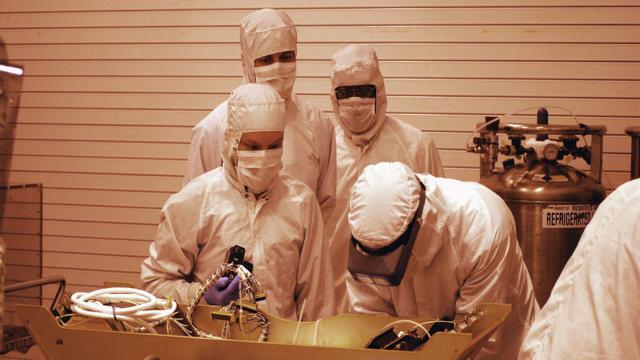The European Space Agency has been collecting examples of “spacecraft-associated biology” in a small collection housed at the Leibniz-Institut DSMZ in Brunswick, Germany. 298 strains of “extremotolerant” bacteria, isolated from spacecraft-assembly rooms because they managed to survive the incredible methods used to clean spacecraft, are now being studied for their biological insight. How on earth can they still be alive?
These “spacecraft-associated microorganisms,” according to a paper by Christine Moissl-Eichingher et al, have been collected, using wipes and swabs, from three different clean rooms. The bacteria have “adapted to a complicated artificial biotope,” the authors explain, which notably understates the case, as these are microorganisms that have lived through the infernal levels of heat shock, atmospheric toxicity, and chemical cleansers used to prepare spacecraft for launch.
While everything around them died, these hearty germs soldiered on — indeed, the bacteria are described as “probably space-travel resistant,” meaning that they could very likely be the first terrestrial organisms to “explore” other worlds (and, of course, could very well already be on Mars).
But this notion — that spacecraft sterilisation protocols are inadvertently helping to cultivate super-organisms — is both amazing and horrific.
Intriguingly, the resulting organisms, stored at the Leibniz-Institut, are considered the intellectual property of the European Space Agency, which suggests that at least someone there has his or her eye on possible future medical developments using these impressively tough little survivors. Will you someday pop an anti-cancer pill based on space-travel resistant super-organisms cultivated in spacecraft-assembly clean room by the European Space Agency? Only time will tell.

The ESA’s ATV Albert Einstein photographed above the Earth.
As a brief footnote to this, the idea of architectural spaces indirectly generating — or, at least, acting as an “artificial biotope” for — unique organisms brings to mind a story from earlier this summer, describing how a “new phylum of bacteria” was “found lurking in [a] hospital sink.”
Of course, it is hardly news that we are surrounded by microbes — the good, the bad, and the nasty — including at least 137 types of bacteria found living in the New York subway system.
But it is worth remembering that architecture is never only populated by the humans who build it, but will always and forever be colonised by other species, creatures as good, and quite possibly better, at making our buildings home.
Top picture: NASA
